
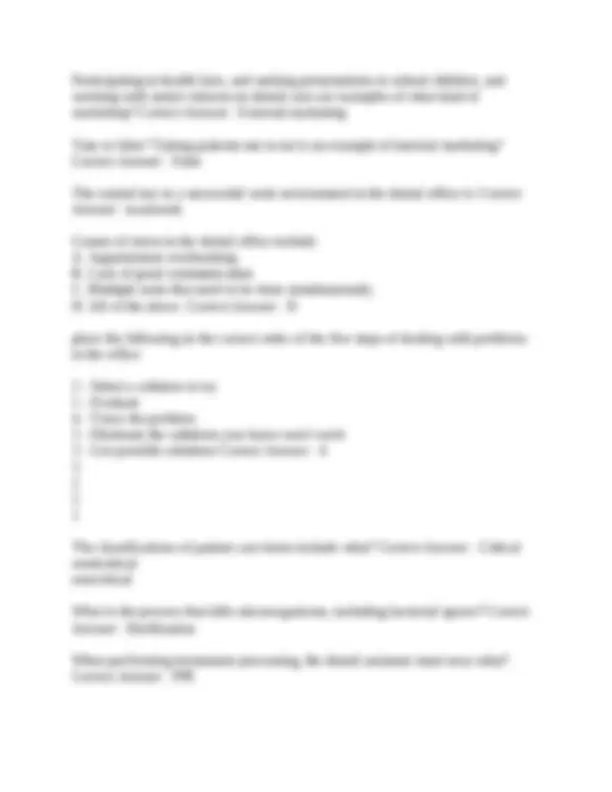
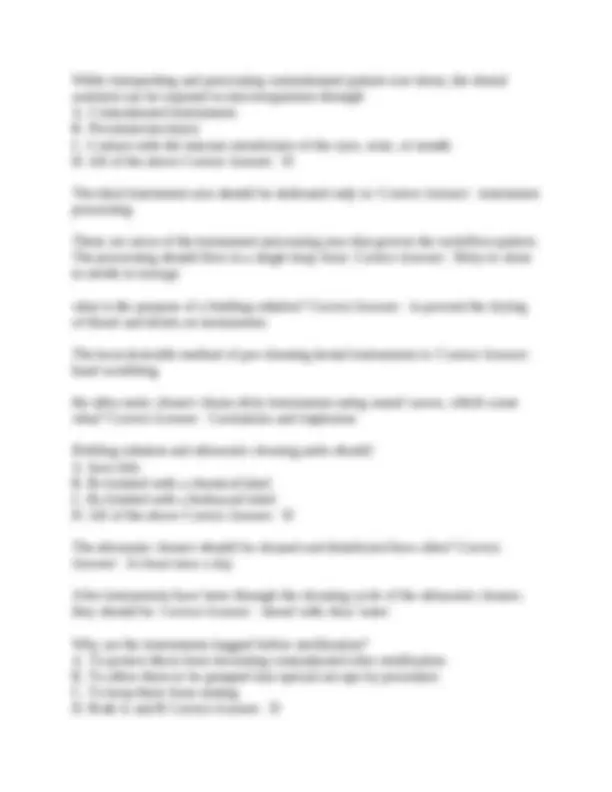
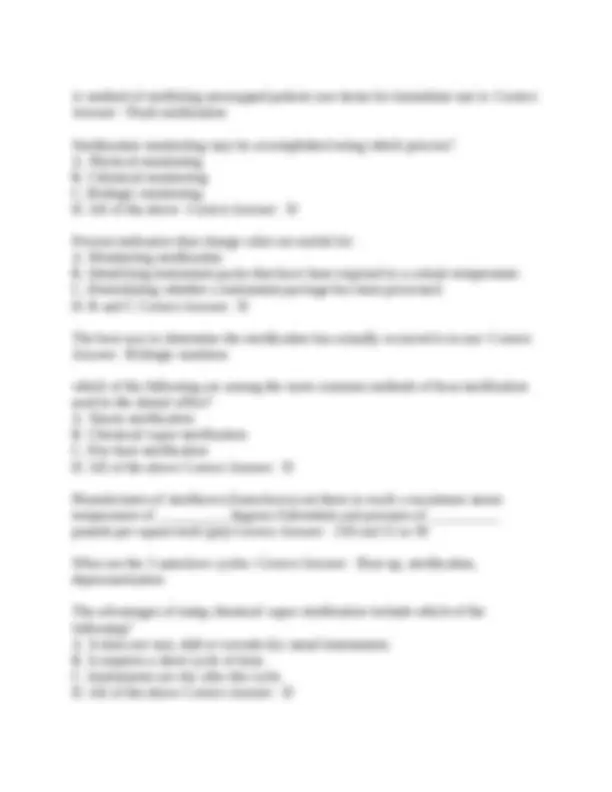
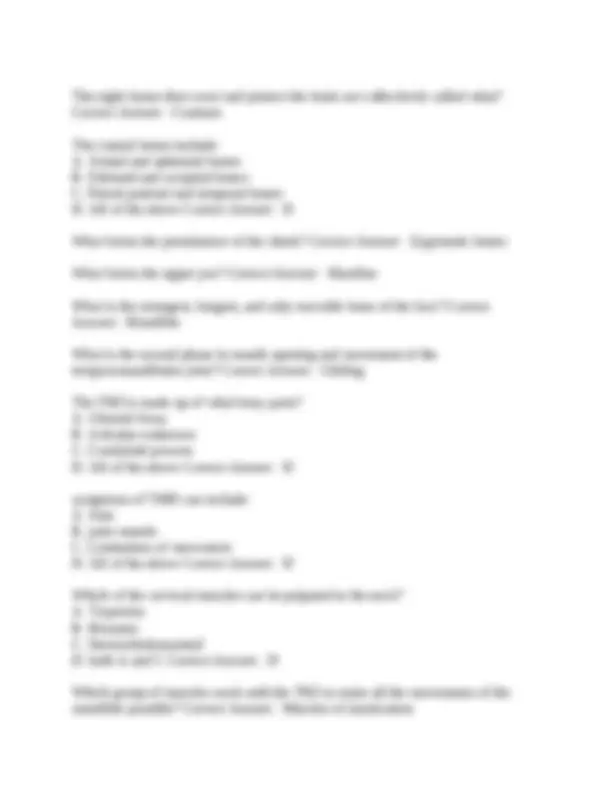
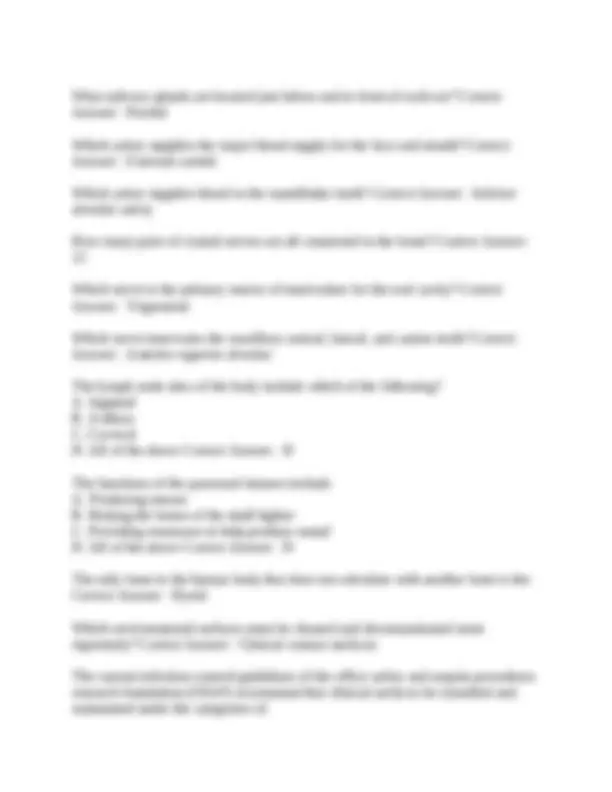
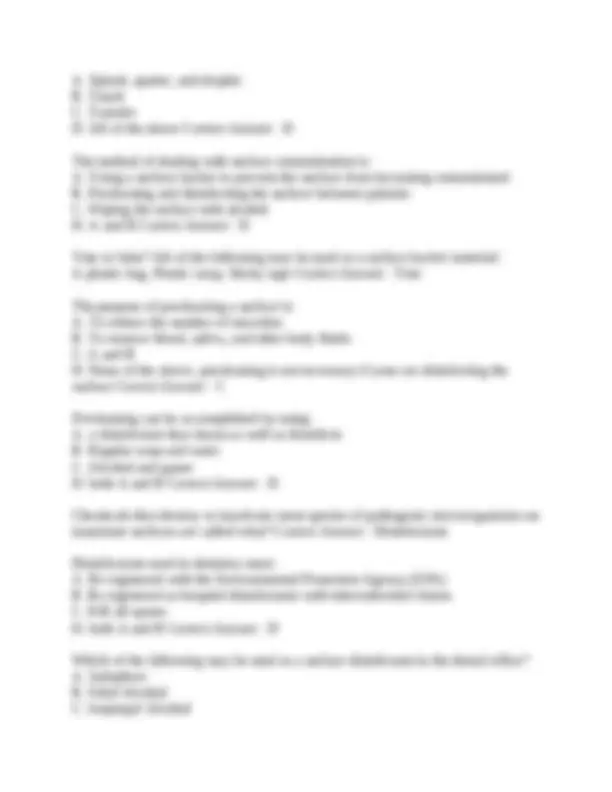
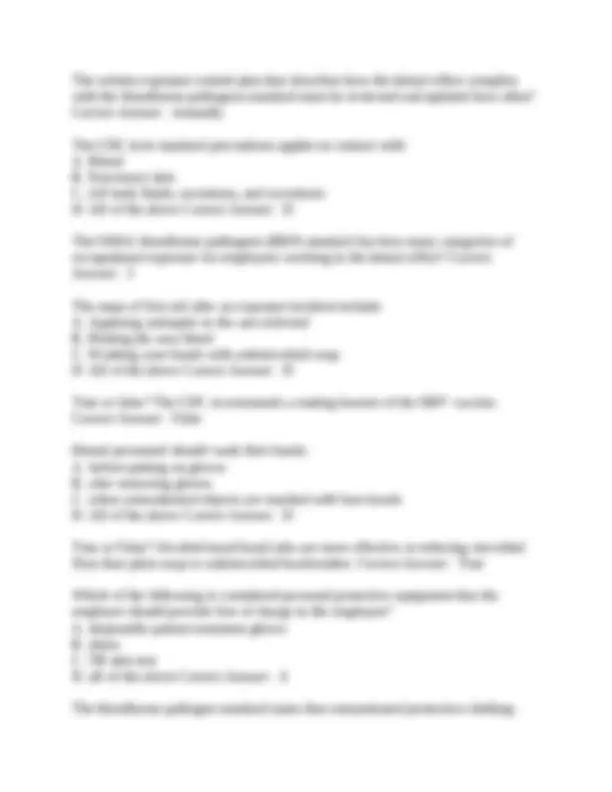
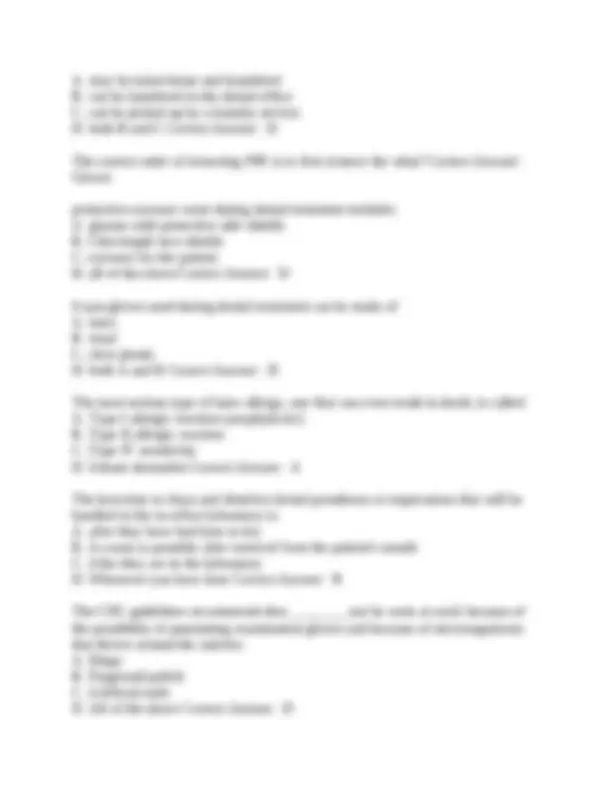
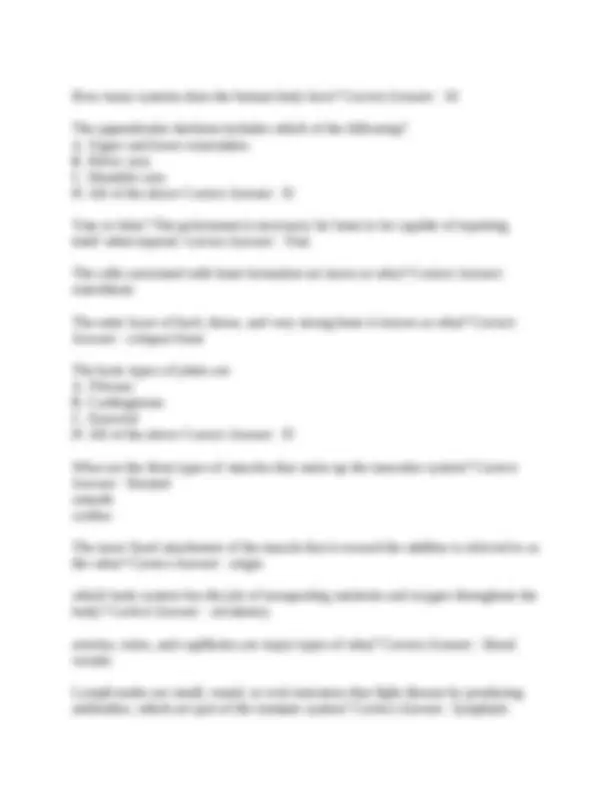
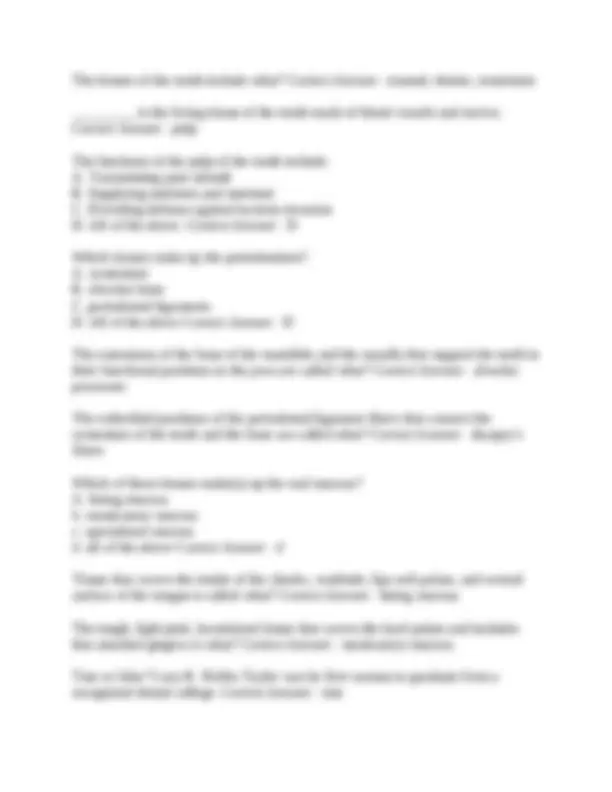
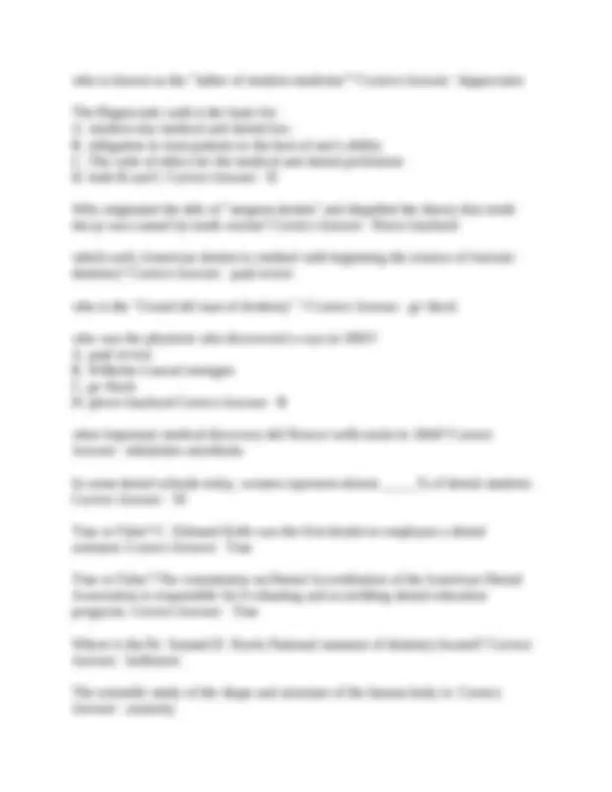
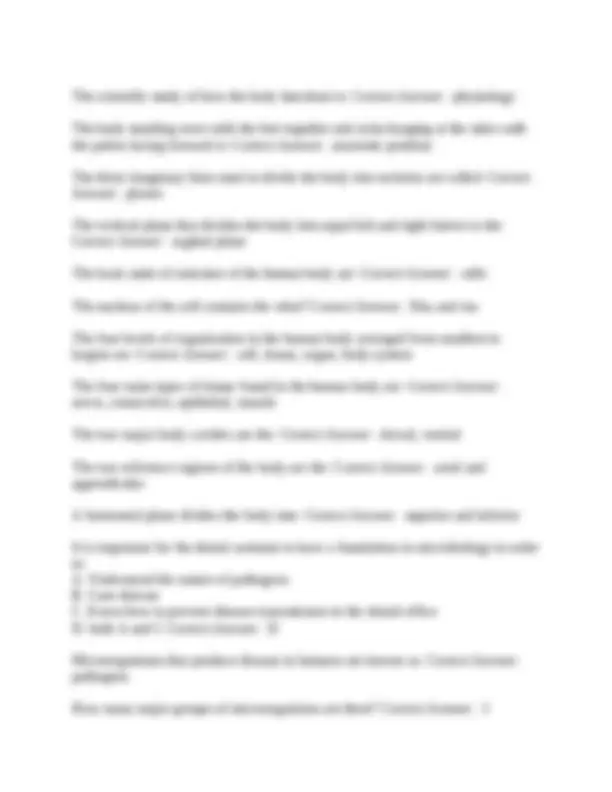
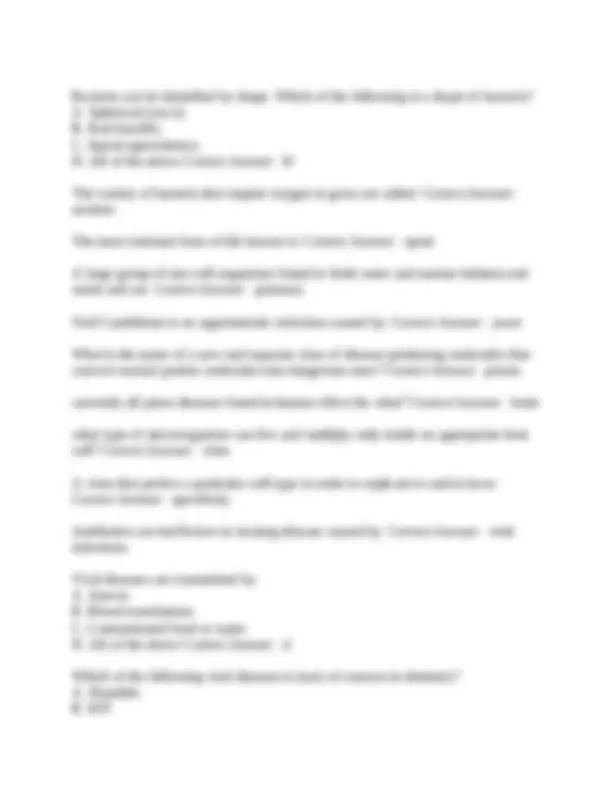
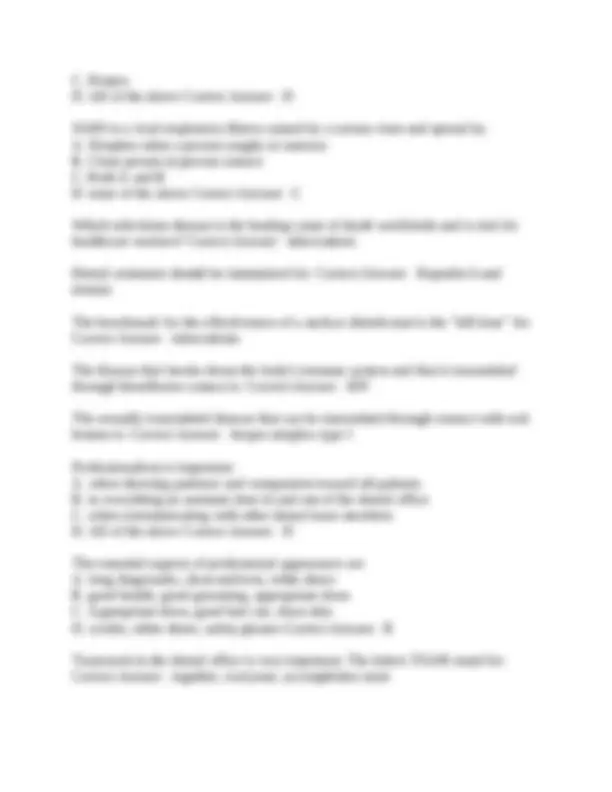
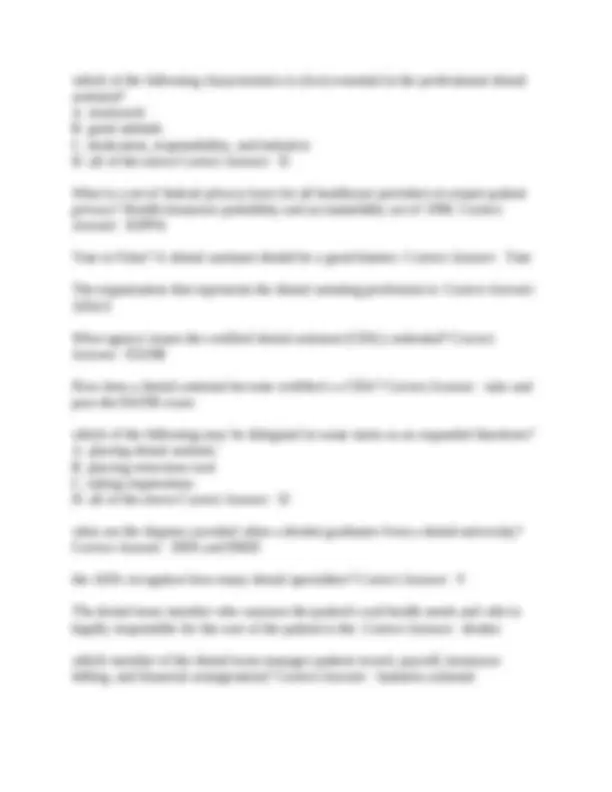
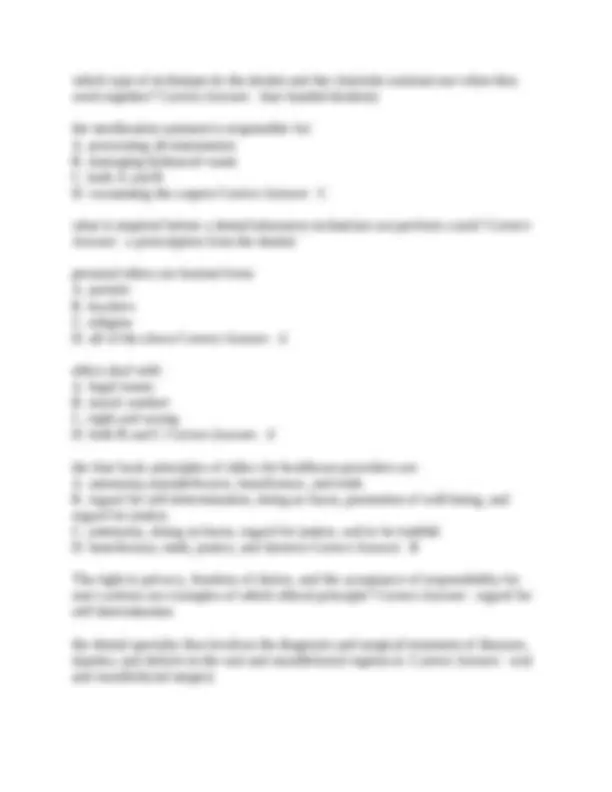
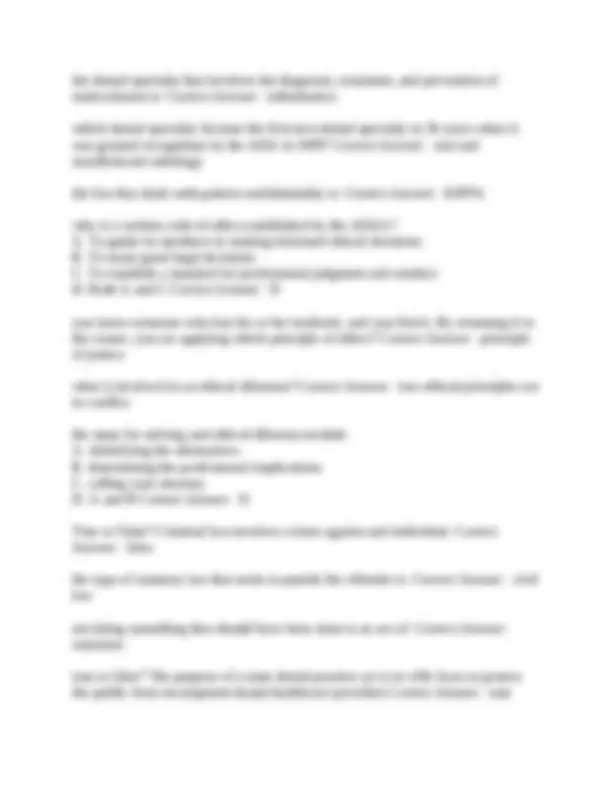
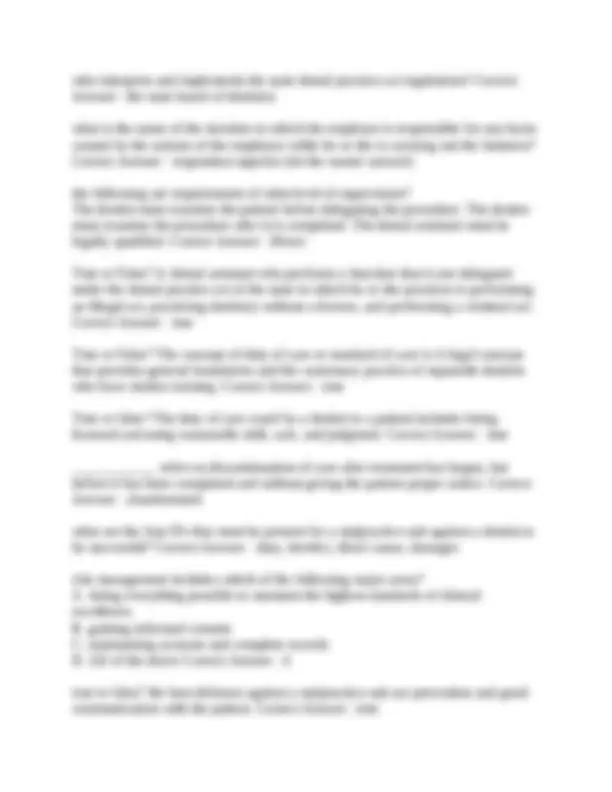
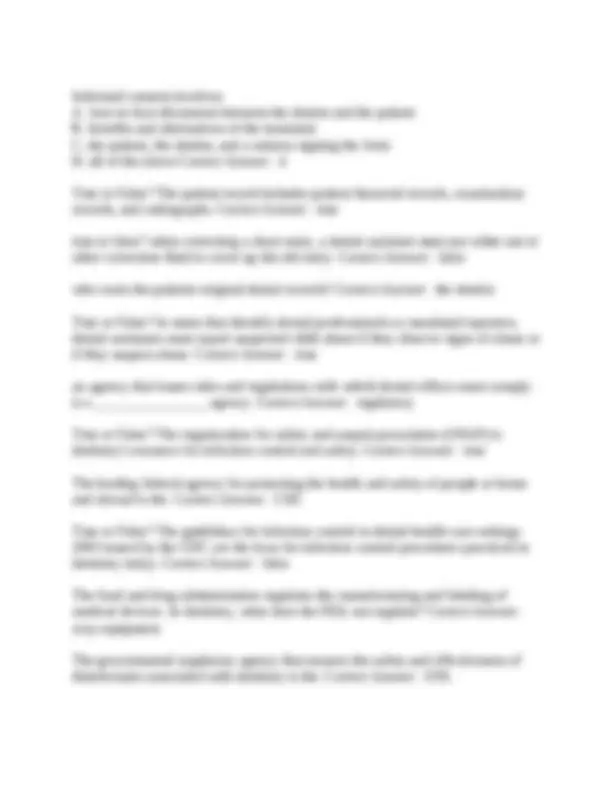
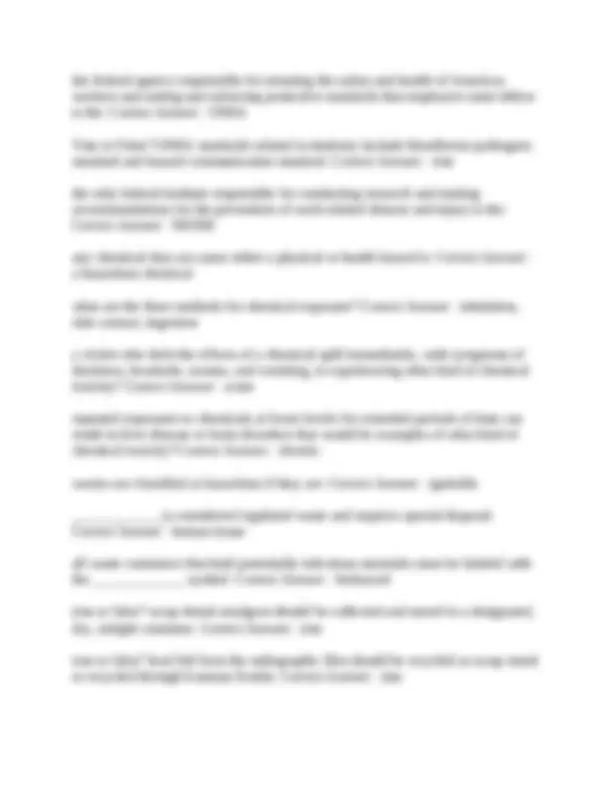
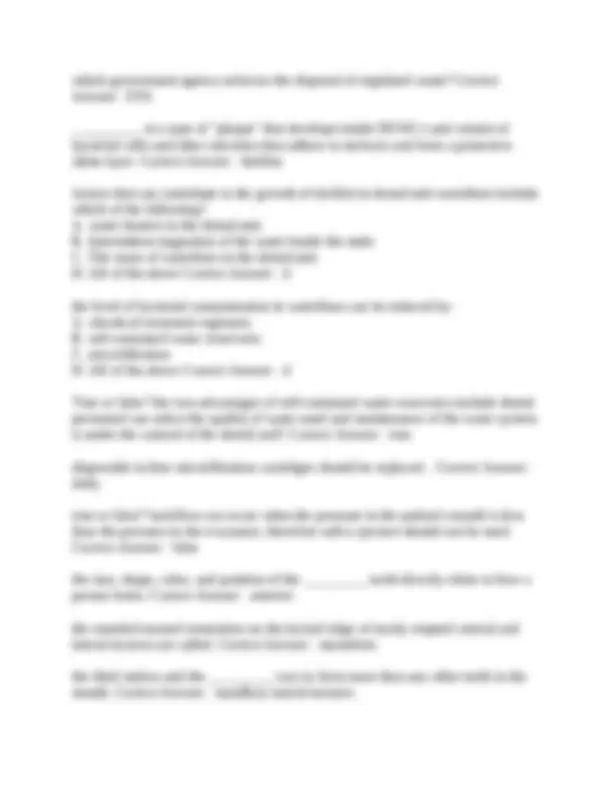
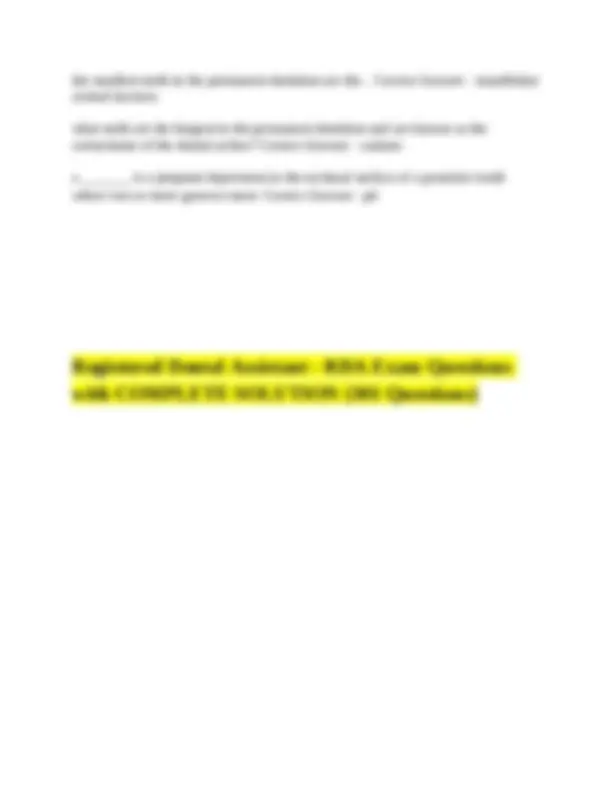



Study with the several resources on Docsity

Earn points by helping other students or get them with a premium plan


Prepare for your exams
Study with the several resources on Docsity

Earn points to download
Earn points by helping other students or get them with a premium plan
Community
Ask the community for help and clear up your study doubts
Discover the best universities in your country according to Docsity users
Free resources
Download our free guides on studying techniques, anxiety management strategies, and thesis advice from Docsity tutors
Registered Dental Assistant - RDA Exam Questions with COMPLETE SOLUTION (301 Questions)Registered Dental Assistant - RDA Exam Questions with COMPLETE SOLUTION (301 Questions)Registered Dental Assistant - RDA Exam Questions with COMPLETE SOLUTION (301 Questions)Registered Dental Assistant - RDA Exam Questions with COMPLETE SOLUTION (301 Questions)
Typology: Exams
1 / 31

This page cannot be seen from the preview
Don't miss anything!
























How many teeth are in the primary dentition Correct Answer: 20 True or False? During the mixed dentition period, children have both primary and permanent teeth? Correct Answer: True How many succedaneous teeth are there? Correct Answer: 20 The permanent dentition period begins at about 12 years of age when..? Correct Answer: The last primary tooth is lost The human mouth is divided into two sections or arches called the? Correct Answer: Maxillary Mandibular The mouth can be divided into four sections called: Correct Answer: Quadrants The anterior teeth include: Correct Answer: Incisors Canines The four types of teeth are: Correct Answer: Incisors canines premolars molars what teeth are the longest teeth in the human dentition and are used for cutting and tearing? Correct Answer: canines what teeth are used for chewing and grinding food? Correct Answer: molars premolars every tooth in the mouth has five surfaces, which are called the: Correct Answer: mesial distal facial lingual masticatory (occlusal or incisal) the general principle concerning the countours of the teeth is true for all teeth: The crown of the tooth _________ toward the cervical line. Correct Answer: Narrows the area where the mesial or distal surfaces of the tooth touch the adjacent tooth in the arch is the: Correct Answer: Contact area the relationship between the maxillary and mandibular teeth when the jaws are in a fully closed position is: Correct Answer: occlusion
The jaw position that produces maximal stable contact between the occluding surfaces of the maxillary and mandibular teeth is: Correct Answer: centric occlusion The key to angle's classification system for occlusion and maloclussion is: Correct Answer: The permanent maxillary first molars which tooth-numbering system is used most often in the US? Correct Answer: Universal numbering system The permanent teeth are ____________ in the Universal numbering system? Correct Answer: numbered 1 to 32 True or False? The ISO/FDI numbering system uses at two-digit numbering system based on quadrants. Correct Answer: True True or False? The Palmer notation system (PNS) is based on quadrants using tooth brackets and letters for the permanent dentition. Correct Answer: False The general categories of communication are: Correct Answer: Verbal and nonverbal Why is voice quality important for a dental assistant? A. It makes up more than one-third of the impact of the total message. B. It is important to cultivate a pleasant voice tone. C. It is important to keep your voice calm so that you do not scare patients. D. All of the above is true. Correct Answer: D Factors that influence the patient's reactions in the dental office can include: A. Previous dental experiences. B. Anxiety and fear of pain. C. Attitudes and beliefs D. All of the above. Correct Answer: D True or False? Having a Dental Hygienist is necessary to ensure that the dental team meets the patient's restorative needs. Correct Answer: False
While transporting and processing contaminated patient care items, the dental assistant can be exposed to microorganisms through: A. Contaminated instruments B. Percutaneous injury C. Contact with the mucous membranes of the eyes, nose, or mouth. D. All of the above Correct Answer: D The ideal instrument area should be dedicated only to: Correct Answer: instrument processing These are areas of the instrument processing area that govern the workflow pattern. The processing should flow in a single loop from: Correct Answer: Dirty to clean to sterile to storage what is the purpose of a holding solution? Correct Answer: to prevent the drying of blood and debris on instruments The least desirable method of pre-cleaning dental instruments is: Correct Answer: hand scrubbing the ultra-sonic cleaner cleans dirty instruments using sound waves, which cause what? Correct Answer: Cavitations and implosion Holding solution and ultrasonic cleaning units should: A. have lids B. Be labeled with a chemical label C. Be labeled with a biohazard label D. All of the above Correct Answer: D The ultrasonic cleaner should be cleaned and disinfected how often? Correct Answer: At least once a day After instruments have been through the cleaning cycle of the ultrasonic cleaner, they should be: Correct Answer: rinsed with clear water Why are the instruments bagged before sterilization? A. To protect them from becoming contaminated after sterilization. B. To allow them to be grouped into special set-ups by procedure. C. To keep them from rusting. D. Both A and B Correct Answer: D
A method of sterilizing unwrapped patient care items for immediate use is: Correct Answer: Flash sterilization Sterilization monitoring may be accomplished using which process? A. Physical monitoring B. Chemical monitoring C. Biologic monitoring D. All of the above. Correct Answer: D Process indicators that change color are useful for: A. Monitoring sterilization B. Identifying instrument packs that have been exposed to a certain temperature. C. Determining whether a instrument package has been processed. D. B and C Correct Answer: D The best way to determine the sterilization has actually occurred is to use: Correct Answer: Biologic monitors which of the following are among the most common methods of heat sterilization used in the dental office? A. Steam sterilization B. Chemical vapor sterilization C. Dry-heat sterilization D. All of the above Correct Answer: D Manufactures of sterilizers (Autoclaves) set them to reach a maximum steam temperature of __________ degrees Fahrenheit and pressure of __________ pounds per square inch (psi) Correct Answer: 250 and 15 to 30 What are the 3 autoclave cycles: Correct Answer: Heat up, sterilization, depressurization The advantages of using chemical vapor sterilization include which of the following? A. It does not rust, dull or corrode dry metal instruments. B. It requires a short cycle of time. C. Instruments are dry after the cycle. D. All of the above Correct Answer: D
The _________ frenum passes from the floor of the mouth to the midline of the ventral border of the tongue. Correct Answer: Lingual True or False? The masticatory mucosa that covers the alveolar process and surrounds the necks of the teeth is the gingiva? Correct Answer: True Normal gingival tissue has which of the following characteristics? A. Surrounds the tooth in collar-like fashion B. Self-cleansing C. Firm, resistant, tightly adapted to tooth and bone D. All of the above Correct Answer: D What type of gingiva forms the soft wall of the gingival sulcus? A. Unattached B. Free C. Marginal D. All of the above Correct Answer: D What is the pear-shaped pad of tissue located behind the maxillary central incisors? Correct Answer: Incisive papilla The U-shaped projection of tissue at the posterior area of the soft palate is the? Correct Answer: Uvula Which of the following is a function of the tongue? A. Positioning food while eating B. Tasting and tactile sensations C. Cleansing the oral cavity D. All of the above Correct Answer: D Where are the taste buds located? A. on the fungiform papillae B. on the filiform papillae C. In the trough of the vallate papillae D. Both a and c Correct Answer: D What provides the sense of touch of the tongue? Correct Answer: Filiform papillae The human skull is divided into what two sections? Correct Answer: Cranium and face
The eight bones that cover and protect the brain are collectively called what? Correct Answer: Cranium The cranial bones include: A. frontal and sphenoid bones B. Ethmoid and occipital bones C. Paired parietal and temporal bones D. All of the above Correct Answer: D What forms the prominence of the cheek? Correct Answer: Zygomatic bones What forms the upper jaw? Correct Answer: Maxillae What is the strongest, longest, and only movable bone of the face? Correct Answer: Mandible What is the second phase in mouth opening and movement of the temporomandibular joint? Correct Answer: Gliding The TMJ is made up of what bony parts? A. Glenoid fossa B. Articular eminence C. Condyloid process D. All of the above Correct Answer: D symptoms of TMD can include: A. Pain B. joint sounds C. Limitations of movement D. All of the above Correct Answer: D Which of the cervical muscles can be palpated in the neck? A. Trapezius B. Masseter C. Sternocleidomastoid D. both A and C Correct Answer: D Which group of muscles work with the TMJ to make all the movements of the mandible possible? Correct Answer: Muscles of mastication
A. Splash, spatter, and droplet B. Touch C. Transfer D. All of the above Correct Answer: D The method of dealing with surface contamination is: A. Using a surface barrier to prevent the surface from becoming contaminated B. Precleaning and disinfecting the surface between patients C. Wiping the surface with alcohol D. A and B Correct Answer: D True or false? All of the following may be used as a surface barrier material: A plastic bag, Plastic wrap, Sticky tape Correct Answer: True The purpose of precleaning a surface is: A. To reduce the number of microbes B. To remove blood, saliva, and other body fluids C. A and B D. None of the above; precleaning is not necessary if your are disinfecting the surface Correct Answer: C Precleaning can be accomplished by using: A. a disinfectant that cleans as well as disinfects B. Regular soap and water C. Alcohol and gauze D. both A and B Correct Answer: D Chemicals that destroy or inactivate most species of pathogenic microorganisms on inanimate surfaces are called what? Correct Answer: Disinfectants Disinfectants used in dentistry must: A. Be registered with the Environmental Protection Agency (EPA) B. Be registered as hospital disinfectants with tuberculocidal claims C. Kill all spores D. both A and B Correct Answer: D Which of the following may be used as a surface disinfectant in the dental office? A. Iodophors B. Ethyl Alcohol C. Isopropyl Alcohol
D. Ammonia Correct Answer: A True or False? The PPE that should be used when cleaning and disinfecting a dental treatment room includes all of the following: A mask, utility gloves, protective eyewear. Correct Answer: True Precautions that should be followed when using glutaraldehyde include: A. Avoiding the fumes B. Always rinsing instruments thoroughly before using them on patients C. Wearing PPE to protect the eyes, skin, and lungs D. All of the above Correct Answer: D What is the high-level disinfectant with very little odor that does not require activation or mixing is: A. Chlorine dioxide B. Glutaraldehyde C. Ortho-phthalaldehyed )OPA) D. Sodium hypochlorite Correct Answer: C The CDC recommendations for environmental infection control concerning clinical contact surfaces suggest: A. Using surface barriers to protect clinical contact surfaces B. Using bariers on difficult-to clean surfaces C. Changing barriers between patients D. All of the above Correct Answer: D The chain of infection consists of four parts including: A. Virulence and number of microrganisms B. Susceptible host and bacterial strength C. Portal of entry and susceptible host D A and C Correct Answer: D The strength of an organism is its ability to produce disease is: Correct Answer: Virulence An infection that is short in duration is: Correct Answer: Acute A disease that can be transmitted in some way form one host to another is: A. An infectious disease B. A communicable disease
The written exposure control plan that describes how the dental office complies with the bloodborne pathogens standard must be reviewed and updated how often? Correct Answer: Annually The CDC term standard precautions applies to contact with: A. Blood B. Non-intact skin C. All body fluids, secretions, and excretions D. All of the above Correct Answer: D The OSHA bloodborne pathogens (BBP) standard has how many categories of occupational exposure for employees working in the dental office? Correct Answer: 3 The steps of first aid after an exposure incident include: A. Applying antiseptic to the area infected B. Making the area bleed C. Washing your hands with antimicrobial soap D. All of the above Correct Answer: D True or false? The CDC recommends a routing booster of the HBV vaccine. Correct Answer: False Dental personnel should wash their hands: A. before putting on gloves B. after removing gloves C. when contaminated objects are touched with bare hands D. All of the above Correct Answer: D True or False? Alcohol-based hand rubs are more effective at reducing microbial flora than plain soap or antimicrobial handwashes. Correct Answer: True Which of the following is considered personal protective equipment that the employer should provide free of charge to the employee? A. disposable patient treatment gloves B. shoes C. TB skin test D. all of the above Correct Answer: A The bloodborne pathogen standard states that contaminated protective clothing:
A. may be taken home and laundered B. can be laundered in the dental office C. can be picked up by a laundry service. D. both B and C Correct Answer: D The correct order of removing PPE is to first remove the what? Correct Answer: Gloves protective eyewear worn during dental treatment includes: A. glasses with protective side shields B. Chin length face shields C. eyewear for the patient D. all of the above Correct Answer: D Exam gloves used during dental treatment can be made of: A. latex B. vinyl C. clear plastic D. both A and B Correct Answer: D The most serious type of latex allergy, one that can even result in death, is called: A. Type I allergic reaction (anaphylactic) B. Type II allergic reaction C. Type IV sensitivity D. Irritant dermatiits Correct Answer: A The best time to clean and disinfect dental prostheses or impressions that will be handled in the in-office laboratory is: A. after they have had time to dry B. As soon as possible after removal from the patient's mouth C. After they are in the laboratory D. Whenever you have time Correct Answer: B The CDC guidelines recommends that ________ not be worn at work because of the possiblilty of puncturing examination gloves and because of microorganisms that throve around the cuticles. A. Rings B. Fingernail polish C. Artificial nails D. All of the above Correct Answer: D
Which body system is the communications system of the body? Correct Answer: nervous The primary center for regulating and coordinating body activities and functions is the what? Correct Answer: brain The body system that delivers oxygen to the cells and transports waste carbon dioxide out of the body is the what? Correct Answer: respiratory True or False? The steps of the digestive process are ingestion, digestion, movement, absorption, and elimination. Correct Answer: true The stomach is part of what body system? Correct Answer: digestive The endocrine system used chemical messengers called __________ that move through the bloodstream. Correct Answer: hormones What important functions does the Integumentary system provide? A. regulates body temperature B. provides a barrier against bacteria from entering the body C. Excretes liquids and salts D. All of the above Correct Answer: D Osteoporosis is an age-related disease of which body system? Correct Answer: skeletal Epilepsy is a disorder of which body system? Correct Answer: nervous Tuberculosis is a disease associated with which body system? Correct Answer: respiratory Diabetes mellitus is a disorder of which body system Correct Answer: endocrine ___________ is a disorder associated with the Integumentary system. A. Renal failure B. Heart attack C. Migraine headaches D. Acne Correct Answer: D
Toxic shock syndrome is a common disorder of which body system? Correct Answer: Female reproductive Embryology is the study of what? Correct Answer: prenatal development The study of the structure and function of the tissues on a microscopic level is: Correct Answer: histology What are the three stages of prenatal development? Correct Answer: preimplantation, embryonic, fetal periods When are the first signs of tooth development found in the anterior mandibular region of the developing embryo? Correct Answer: when the embryo is 5 to 6 weeks old Developmental disturbances can be caused by: A. genetic factors B. Environmental factors C. A and B D. None of the above Correct Answer: C The process of laying down new bone is called ___________; it is accomplished by cells called ___________. Correct Answer: deposition, osteoblasts What are the three primary periods of odontogenesis? Correct Answer: Growth, calcification, eruption ___________ are enamel-forming cells. Correct Answer: Ameloblasts The movement of the teeth into their functional positions in the oral cavity is known as what? Correct Answer: eruption The term ______________ is used for a permanent tooth that replaces a primary tooth. Correct Answer: succedaneous The portion of the tooth that is covered with enamel is the? Correct Answer: anatomic crown Every tooth is divided into the what? Correct Answer: crown and root
who is known as the "father of modern medicine"? Correct Answer: hippocrates The Hippocratic oath is the basis for: A. modern-day medical and dental law. B. obligation to treat patients to the best of one's ability C. The code of ethics for the medical and dental profession D. both B and C Correct Answer: D Who originated the title of "surgeon dentist" and dispelled the theory that tooth decay was caused by tooth worms? Correct Answer: Pierre fauchard which early American dentist is credited with beginning the science of forensic dentistry? Correct Answer: paul revere who is the "Grand old man of dentistry"? Correct Answer: gv black who was the physicist who discovered x-rays in 1895? A. paul revere B. Wilhelm Conrad roentgen C. gv black D. pierre fauchard Correct Answer: B what important medical discovery did Horace wells make in 1844? Correct Answer: inhalation anesthesia In some dental schools today, women represent almost _____% of dental students. Correct Answer: 50 True or False? C. Edmund Kells was the first dentist to employee a dental assistant. Correct Answer: True True or False? The commission on Dental Accreditation of the American Dental Association is responsible for Evaluating and accrediting dental education programs. Correct Answer: True Where is the Dr. Samuel D. Harris National museum of dentistry located? Correct Answer: baltimore The scientific study of the shape and structure of the human body is: Correct Answer: anatomy
The scientific study of how the body functions is: Correct Answer: physiology The body standing erect with the feet together and arms hanging at the sides with the palms facing forward is: Correct Answer: anatomic position The three imaginary lines used to divide the body into sections are called: Correct Answer: planes The vertical plane that divides the body into equal left and right halves is the: Correct Answer: sagittal plane The basic units of structure of the human body are: Correct Answer: cells The nucleus of the cell contains the what? Correct Answer: Dna and rna The four levels of organization in the human body arranged from smallest to largest are: Correct Answer: cell, tissue, organ, body system The four main types of tissue found in the human body are: Correct Answer: nerve, connective, epithelial, muscle The two major body cavities are the: Correct Answer: dorsal, ventral The two reference regions of the body are the: Correct Answer: axial and appendicular A horizontal plane divides the body into: Correct Answer: superior and inferior It is important for the dental assistant to have a foundation in microbiology in order to: A. Understand the nature of pathogens B. Cure disease C. Know how to prevent disease transmission in the dental office D. both A and C Correct Answer: D Microorganisms that produce disease in humans are known as: Correct Answer: pathogens How many major groups of microorganisms are there? Correct Answer: 5